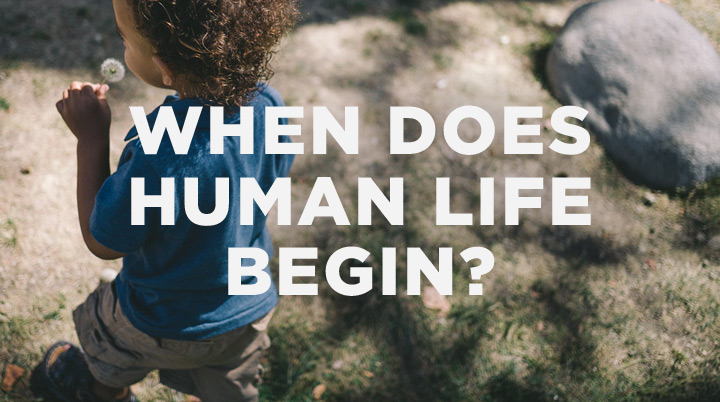Latest
-
Objections to the Christian Faith from the Unchurched and De-Churched
 Tue Dec 02, 2014
Tue Dec 02, 2014
by Resurgence -
Craig Groeschel: We Innovate for Jesus
 Tue Oct 14, 2014
Tue Oct 14, 2014
by Resurgence -
Mark Driscoll: Revelation
 Tue Oct 07, 2014
Tue Oct 07, 2014
by Resurgence -
RESURGENCE LEADERSHIP #034: JOHN PIPER, WHY I TRUST THE SCRIPTURES, PART 2
 Tue Sep 30, 2014
Tue Sep 30, 2014
by Resurgence -
Resurgence Leadership #033: John Piper, Why I Trust the Scriptures, Part 1
 Tue Sep 23, 2014
Tue Sep 23, 2014
by Resurgence

Archives
When does human life begin?

A baby in a mother’s arms deserves the same legal protection as a baby in a mother’s womb.
This week marks the 40th anniversary of Roe v. Wade and the bloodiest era in world history. Since the Supreme Court’s decision in 1973, about 50 million children have been killed as a result of legal abortions in the United States alone.
Of course, not everyone acknowledges this tragedy because not everyone recognizes the legitimacy of life in the womb. Because human beings are God’s image bearers and bestowed with particular dignity, value, and worth, the question of when life begins is incredibly important. The widespread practice of abortion and the issue of whether abortion is in fact the taking of a human life, and therefore murder, heighten the importance of this question.
When life begins according to science
Scientifically and medically, it is beyond debate that human life begins at conception. From the initial joining of sperm and egg, the tiny baby is alive, distinct from its mother, and living and growing as a human. While the ability to express humanity and personhood change throughout the life cycle, human essence and human personhood are innate to the living being. No matter how tiny or weak, humans deserve support and protection because they are God’s image bearers. Princeton professor and member of what was formerly the President’s Council on Bioethics, Robert P. George, rightly says:
Human embryos are not . . . some other type of animal organism, like a dog or cat. Neither are they a part of an organism, like a heart, a kidney, or a skin cell. Nor again are they a disorganized aggregate, a mere clump of cells awaiting some magical transformation. Rather, a human embryo is a whole living member of the species Homo sapiens in the earliest stage of his or her natural development. Unless severely damaged, or denied or deprived of a suitable environment, a human being in the embryonic stage will, by directing its own integral organic functioning, develop himself or herself to the next more mature developmental stage, i.e., the fetal stage. The embryonic, fetal, child, and adolescent stages are stages in the development of a determinate and enduring entity—a human being—who comes into existence as a single-celled organism (the zygote) and develops, if all goes well, into adulthood many years later.
But does this mean that the human embryo is a human person worthy of full moral respect? Must the early embryo never be used as a mere means for the benefit of others simply because it is a human being? The answer . . . is “Yes.”
When life begins according to Scripture
Furthermore, there are many texts of Scripture that confirm human life does begin at conception and that an unborn baby is an image bearer of God. Psalm 51:5 reveals that we are not only human beings but sinners from conception: “Behold, I was brought forth in iniquity, and in sin did my mother conceive me.” God called both Isaiah and Jeremiah for prophetic ministry from their mothers’ wombs (Isa. 49:1; Jer. 1:5). Luke 1:15 says that John the Baptizer “will be filled with the Holy Spirit, even from his mother’s womb.”
Perhaps the most extensive section of Scripture on human life in the womb is Psalm 139:13–16, which says:
For you formed my inward parts;
you knitted me together in my mother’s womb.
I praise you, for I am fearfully and wonderfully made.
Wonderful are your works;
my soul knows it very well.
My frame was not hidden from you,
when I was being made in secret,
intricately woven in the depths of the earth.
Your eyes saw my unformed substance;
in your book were written, every one of them,
the days that were formed for me,
when as yet there was none of them.
Christians have always followed the teaching of the Old Testament Jews, that abortion of a preborn child and exposure of a born child are both murderous sins. In the Didache, which was an ancient manual for church instruction, we read, “You shall not commit murder. . . . You shall not procure abortion, nor commit infanticide” (Didache 2:2).
Some will argue that there is a difference between a child in a mother’s womb and one outside of it, yet the early church saw both as equally living people and the taking of life in either state as equally murderous. Their convictions were based on Scripture, which uses the same word (brephos) for Elizabeth’s unborn child (John the Baptizer) in Luke 1:41, 44 as is used for the unborn baby Jesus in Mary’s womb (Luke 2:12) and also for the children brought to Jesus (Luke 18:15).
Simply, in the divinely inspired pages of Scripture, God reveals to us that a child in the womb and a child singing and dancing around Jesus in worship are equally human beings who bear the image of God, and thankfully Mary did not abort the “tissue” in her womb, because he was God.
Medical, scientific, and theological sources agree that human life begins at conception. Therefore, not to extend legal protections to preborn children because of age, size, or phase of development is a grievous discrimination and injustice akin to racism, sexism, and ageism.
Related resources
- “15 things to consider about abortion,” from John Piper.
- Pastor Mark interviews bestselling author Randy Alcorn about abortion, the pro-life movement, and family planning.
- In his sermon from Luke 1:39–45, Pastor Mark explains what we can learn about abortion, personhood, and life from the pregnancies of Mary and Elizabeth.
- “The Slaughter of the Innocents.” On the Newtown massacre, abortion, and Herod’s attempt to murder Jesus.
- Mars Hill Pastor AJ Hamilton shares his testimony and gives a strong encouragement for women considering abortion, as his mother was, that God can redeem any situation.
Adapted from Doctrine: What Christians Should Believe by Mark Driscoll and Gerry Breshears copyright © 2010. Used by permission of Crossway, a publishing ministry of Good News Publishers, Wheaton, Il 60187, www.crossway.org.